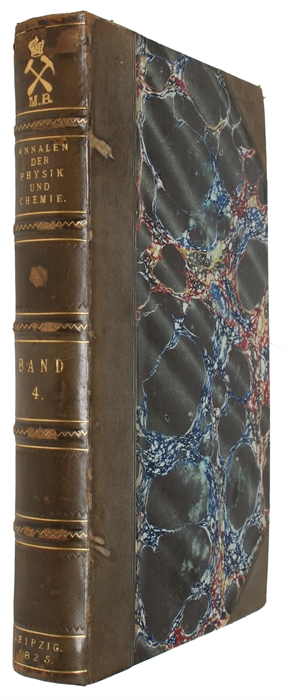OHM, GEORG SIMON. - THE PRELIMINARY ANNOUNCEMENT OF OHM'S LAW.
Vorläufige Anzeige des Gesetzes, nach welchem Metalle die Contaktelectricität leiten;
Leipzig, Johann Ambrosius Barth, 1825. Contemp. hcalf. 5 raised bands, gilt spine and gilt lettering to spine. A few scratches to spine. Small stamp on verso and on titlepage. A tear to right margin of titlepage repaired. In: "Annalen der Physik und Chemie. Hrsg. von J.C. Poggendorff", Poggendorff Bd. 4. (10),476 pp., 4 large folded tables, 6 engraved plates, some folding. Small stamp on verso of plates. Ohm's paper: pp.79-88. Internally fine and clean.
First appearance of a paper of outmost importence in the history of electricity, - it is Ohm's first scientific paper, and it contains the report on the different original experiments (sending a current through a variety of test wires) that was the foundation for his famous law, Ohm's Law. The paper contains the original research material that was to immortalize his name, for the mathematical formulation of the law two years later in the well-known work "Die galvanische Kette, mathematisch bearbeitet" (1827). - This paper was at the same time published in Schweiggers Journal.
"Ohm's first scientific paper was "Vorläufige Anzeige des Gesetzes..." (the paper offered). In it he sought a functional relationship between the decrease in the electromagnetic force excerted by a current-carrying wire and the lenght of the wire...Fromthe zinc and copper poles of a voltaic pile he ran two wires, A and B, the free ends of which terminated in small mercury-filled cups, M and N; between M and another cup, O, he ran a third wire, C. Together A,B, and C formed what he called the "invariable conductor", to distinguish it from one of the seven wires of different lenghts that, when placed in a circuit between O and N, constituted the "variable conductor". Among the latter was one "veru thick" wire, four inches long, and six thinner ones, 0.3 line (.025") in diameter, ranging in lenght from one foot to seventy-five feet. Finally, over wire C hung the magnetic needle of a Coulomb torsion balance, which served to measure the electromagnetic force exerted when one of the variable conductors completed the circuit....(He then found that) the loss in force was equal to the difference between the normal force and the lesser force occasioned by one of the other wires, divided by the normal force. Tabulating these value against the lenghts of the wires, he found that his data were well represented by the formula v=0.41 log (1+x), where v is the loss in force and x is the lenght of the wire in feet...."(DSB X, p.187). - This expression is the preliminary formula for his famous relations between voltage, amperage and resistance, R=V/I.
Parkinson "Breakthrough" 1825 P. - Ronald's Library p. 376.
The volume contains other importent papers in the history of chemistry and physics, Berzelius, F. Wöhler, F.E. Neumann, Heinrich Rose, Chr. Hansteen, Fresnel etc.
Order-nr.: 43090

